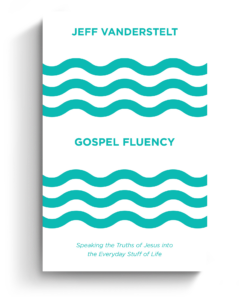It was a warm summer evening, and the crowd was ready to sing. The sun was setting over the Iroquois Amphitheater, and a man in a white suit was working his way through the rows of seats, one hand in the air, his shoulders stooped and his voice graveled by age. He sang and beckoned us to sing along, directing haphazardly with the movements of his hands, the crowd breathing in unison as we sang along.
It’s a dying art in America, a vestige of long-gone days. There was a time when such a gathering was fairly commonplace, when a community would gather and sing, when there was a body of shared, well-known songs. But today such outings are rare. The man in the white suit knows it too, and for much of the last 20 years he has self-consciously played up the fact that he and his traveling road show are a bit of a cultural dinosaur.
It wasn’t a church gathering, and it wasn’t a revival. It wasn’t even gospel music; it was A Prairie Home Companion, National Public Radio’s old-timey radio variety show.
Garrison Keillor, the show’s host and star, had taken a long break from the show’s sketches and musical performances to meander through the crowd and invite them to sing. He sang a hodgepodge of songs. A verse of Paul McCartney might segue into “It Is Well” or “Home on the Range,” hoping that the audience might know one well enough to jump in and sing along.
Creational Power
Keillor had tapped into the creational power of singing. We’re embodied creatures, and there are deep connections between our bodies and souls. Practices like singing stir our hearts to joy and affection, and Keillor was basking in it.
It fascinated me as a worship leader to watch this master entertainer at work. He kept remarking about how “people don’t do this anymore,” and in many ways he’s right. A community “sing” is a bygone relic. Frankly, in many ways, so is the blockbuster hit song. Lennon and McCartney’s tunes took over the airwaves in an era when there were few avenues for getting music out to the consumer. Today, music is much more niche, and mobile technology puts the listener in control of what they hear to a much greater degree. For a hit to become a ubiquitous singalong is much, much more difficult.
This kind of stylistic niche marketing has shown up in the church too, and a local church’s music tends to be stylistically narrow. Contemporary music is part of an outreach strategy, a way of connecting with people who don’t identify with the typical sounds and styles of congregational music. In this way, music primarily expresses culture, driven by attitudes and ideas about beauty, creativity, and context.
There’s much debate about this approach of course, with some crying for more concern for content and others claiming that the stylistic choices have either gone too far or not far enough.
Missing the Point
I can’t help but wonder, though, if we haven’t—at least partially—missed the point. While style and content both matter, I wonder if we shouldn’t devote a little more time to something even more fundamental—the creational power of singing.
When we talk “worship” we are almost always talking about redemption and its effects, and that’s for good reasons. But when we talk about singing, we’re also in the territory of creation, of being “fearfully and wonderfully made.” Singing itself is creational gift with formational effects.
When people sing together, they literally unite their breath. They unite their words. In certain situations, they’ll unite their physical gestures too—clapping and raising hands.
Music also has physiological effects, which are intensified when you participate in making the music (by, for instance, singing along). Music with ascending melodies, up tempos, and major keys tends to lift the mood and elevate the pulse. Music with descending melodies, minor keys and down tempos (unsurprisingly) does the opposite.
As embodied creatures, congregational singing takes advantage of our bodies—our breathing and singing and the effects of music upon the body—to unite us and take us on a journey together. It’s just such a uniting, physical, and emotional effect that Garrison Keillor seeks as he sings “Yesterday” and “I’ve Got Rhythm” and “How Great Thou Art” with his audience. Their bodies and their hearts embark on a journey together.
One might object, “Isn’t that manipulative? Worship leaders shouldn’t use music to manipulate emotions!”
Ah, but here’s the problem: try to use music in a way that doesn’t affect us emotionally. Music comes to us through our bodies, and our bodies and souls can’t be disconnected from one another. The Bible calls us to sing and make music together, and when we do that, we will inevitably invoke the physical effects of music on our bodies; we are created with that wiring already in place. The body is either a problem to be solved or part of the reason we’re called to sing.
Truth, Beauty, Action
At its best, congregational music is a marriage of truth, beauty, and action. Songs that are clear and comprehensible to a congregation, loaded with biblical truth, are set to music that “paints” that text emotionally. By singing with the church, I’m putting truth and beauty into action within me. I’m confessing the truth as I experience its effects. I am “speaking the truth in love” with the church, which as David Peterson points out, is not a reference to interpersonal confrontation, but communal confession. We speak the truth in love when we join our voice with the church, singing together of who God is and what he’s done.
In singing, the whole person is engaged. In congregational singing, the whole person is engaged and united with the community around us. This practice takes on its greatest meaning in the church, where that unity shapes and reorients a covenant community to the story of the gospel. When the church sings a lament together, the words and music share the sense of sorrow and anguish of those who are suffering. When they sing a celebratory anthem, the music helps them emotionally taste hope and victory.
It is dangerous to pursue the emotional effect of music without rooting it in the content of God’s Word. But it’s also dangerous to pretend that music’s emotional effects are unimportant or dangerous in themselves. To be stirred by singing is to be human, and it’s a means of grace to God’s church that such a gift is so easily accessible. You don’t even need rock band, or a pipe organ, or a guy with a faux hawk and an acoustic guitar. You just need a song and a reason to sing.
“The Most Practical and Engaging Book on Christian Living Apart from the Bible”
 “If you’re going to read just one book on Christian living and how the gospel can be applied in your life, let this be your book.”—Elisa dos Santos, Amazon reviewer.
“If you’re going to read just one book on Christian living and how the gospel can be applied in your life, let this be your book.”—Elisa dos Santos, Amazon reviewer.
In this book, seasoned church planter Jeff Vanderstelt argues that you need to become “gospel fluent”—to think about your life through the truth of the gospel and rehearse it to yourself and others.
We’re delighted to offer the Gospel Fluency: Speaking the Truths of Jesus into the Everyday Stuff of Life ebook (Crossway) to you for FREE today. Click this link to get instant access to a resource that will help you apply the gospel more confidently to every area of your life.

































